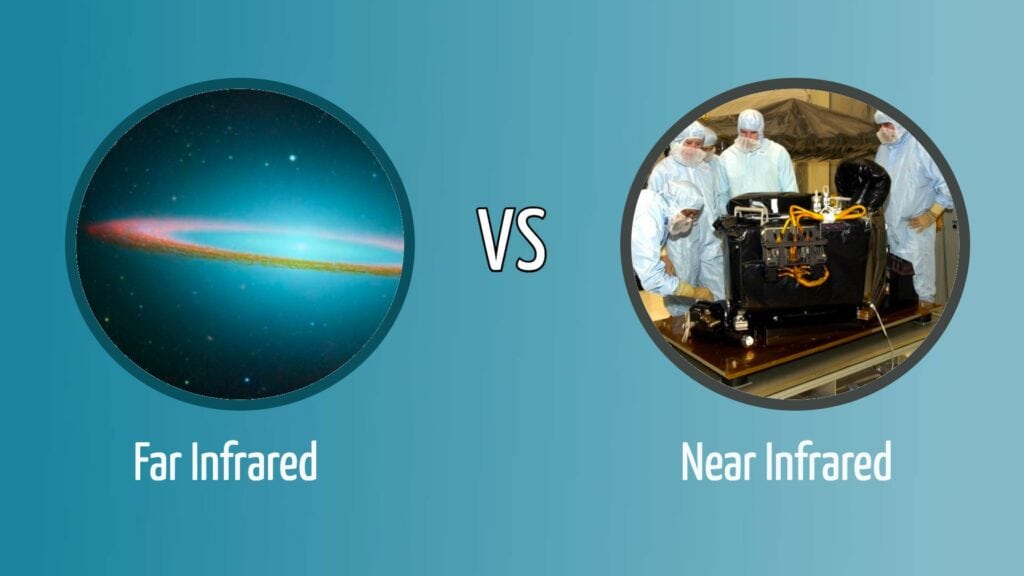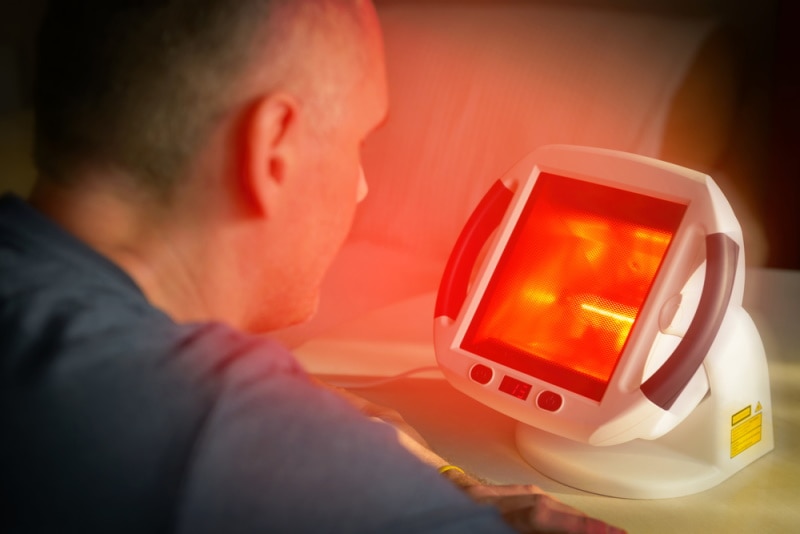Far Infrared vs Near Infrared: What’s The Difference?
Last Updated on

In some circles, infrared waves are also referred to as light waves. And they make up part of something called an electromagnetic spectrum. This spectrum has radiations such as radio waves and gamma rays, all different frequencies. For the record, the visible light that we can detect and see is also found on that spectrum.
Infrared is invisible, and its frequencies or wavelengths vary. That’s the reason why we’re here today. It’s because of that variation that we now have near infrared and far infrared.

Near Infrared: Overview

According to scientists, our eyes don’t have the faculties to see any form of radiation on the light spectrum that has a wavelength of 700nm and above. Unfortunately for us, that’s the position occupied by infrared radiation. So, if we had to define near-infrared, we’d say it’s the type of light that’s closest to the visible light on our electromagnetic spectrum.
The other sad fact is that we cannot even feel them, as they don’t generate any heat. They are just microscopic waves that are powerful enough to power up a sauna. Yes, you read that right. Since they have a higher frequency, they often carry more energy compared to the far infrared. Thus, making them the ideal option to install in saunas.
Two factors influence the quantity of energy being carried by a wave, as per the rules of science. That is the amplitude and the frequency. The amplitude is basically half the distance covered in a vibrational path. For example, if an elastic body moves from point A to C in a vibrational fashion, B being the middle point, AB will be the amplitude. Alternatively, you could go with BC.
There is a rule in physics that goes: the square of a wave’s amplitude is directly proportional to the energy being transmitted. Therefore, if the amplitude changes for some reason, the square of that effect will cause a shift in the energy levels.
Frequency, on the other hand, is the measurement of occurrence in a specified time period. For instance, how many times does the body move from A to C in one second? Near-infrared light usually creates waves that are more frequent compared to far infrared. Consequently, carrying more energy.
The unique properties of near-infrared waves have made it a vital tool for industries looking for solutions that can be utilized to analyze chemical compositions. So don’t be surprised to hear of agrochemical production plants and pharmaceutical organizations applying this wave to their operations.

Far Infrared: Overview

The far infrared waves are also not visible to the naked eye but are thermal in nature. And that’s the one advantage that they hold over the near-infrared radiation. In addition, this is the type of wave that we are all most familiar with, as it’s the heat we feel when we go outside to bask in the sun. The bonfire that we always surround during camping is yet another source of far infrared radiation.
On the electromagnetic spectrum, these waves lie near the microwave region. But that’s certainly not a coincidence considering the microwaves are what we rely on when it comes to heating food.
While studying the different waves on the spectrum, the far infrared was found to have therapeutic properties. And since then, they’ve been installed in a wide variety of health products designed to help us fortify our immune systems. Those same properties are still effective at revitalizing skin cells and healing damaged tissue.
Examples of far infrared products being sold for healing purposes include heat lamps, customized massagers, specific minerals, and select wraps. You can use the wraps on your elbows or support your ankles and even knees.
Far infrared waves might not be able to carry more energy, but their longer wavelengths make them the ideal option for sauna users looking for a deeper energy penetration.
Far Infrared vs Near Infrared: What Are the Health Benefits?
Boosting Blood Circulation
When applied therapeutically, infrared can improve the circulation of blood in our systems. All the while making sure the individual doesn’t feel any degree of pain or feel uncomfortable.
But if you are given the option to choose, go with a far infrared heating unit. Unlike its near-infrared compatriot, it has the requisite frequency to deeply penetrate our various body tissues, to not only stimulate blood flow, but also facilitate muscle recovery, reduce inflammation, and minimize pain.

Eliminating Toxins
Infrared saunas have gained so much popularity over the years because they are effective at eliminating toxins from our systems. After just three to four sessions, you’ll be able to see the results. Your skin will be glowing because there won’t be any toxins left in the pores, and your state of mind will be in a better place.
From a psychiatric perspective, the toxins that eventually gain access to our bodies are detrimental to our general health. They are part of the reason why you’re constantly experiencing brain fog, going through bouts of depression, and exhibiting psychotic behavior.
Toxins can hide on the topical surface of our skin and in the deep tissue. So far infrared will help you get rid of those that are hiding within, while near-infrared works on the topical stuff. That sweating component is vital in the process as it’s the avenue through which the toxins are released. Hence, cleansing your skin from the inside out.
Burning Calories
While we’re still on this topic of saunas, it’s imperative to add that various studies have found that people who visit them frequently end up burning lots of calories in the process. Apparently, the far infrared’s ability to deeply penetrate our skin tissue is beneficial to anyone looking to burn 200 to 600 calories, in a 30-minute session. It achieves that by slightly raising our Human Growth Hormones, pushing down our cortisol levels, and ultimately stimulating our metabolism.
However, that doesn’t mean that near-infrared radiation is useless in this aspect. It also contributes by slowly raising our core body temperature. It’s common knowledge that whenever we feel hot, we end up burning more calories. Our cardiovascular systems are compelled to work twice as hard to pump enough blood around, thereby consuming more energy.

Relaxations
You might not be able to visibly see your skin glow after just one session, but you’ll definitely feel relaxed. And this sentiment is shared by almost all infrared sauna users from around the world. The cortisol hormone that we just mentioned is a stress hormone. If its levels are unusually high, you’re likely to face some serious health issues, including osteoporosis and cardiovascular diseases. By mimicking your body’s emissions, what the waves end up doing is assisting your muscles to loosen up and relax.

How Safe is Infrared Radiation?
Infrared radiations are not the same as ultraviolet rays. They’ve been studied by experts well over-qualified in the medical field and found to be very safe. That’s why they are widely used in hospitals to warm up newborns. The heat generated is not strong enough to burn your skin or that of the baby.
Precautions have to be taken, though. Not being able to get a burn doesn’t mean that overheating isn’t a possibility. You certainly can, and that’s why medical experts recommend hydrating every couple of minutes.
Also, you have to be medically cleared before using an infrared sauna. If you don’t go for a checkup and you have an undiagnosed or preexisting medical condition, things can quickly get dangerous.
What’s The Difference Between Conventional Heat and Infrared Heat?

We’ll explain the difference from a sauna perspective. When you enter a traditional sauna, it will first heat the air around you. That air will in turn heat your skin, and eventually, raise your core body temperature. But the infrared heat doesn’t work by first heating up the air. The wavelengths directly penetrate your skin, to raise the core body temperature.
There’s also the other aspect of temperature difference. In the infrared sauna, the highest temperature will be 140º Fahrenheit. That means it’s always lower than the lowest temperature applied in a conventional sauna.
Does that mean the health benefits are limited? No. The infrared sauna doesn’t need unreasonably high temperatures because it can gain direct access to your internal tissues. Unlike the traditional saunas which have to first make sure that the air around you is at an optimal temperature.

Final Thoughts
The difference between near infrared and far infrared is simple—distance. The former is closer to visible light on the spectrum than the latter. They both can’t be detected by the naked human eye, but far infrared can generate heat. If we’re talking about which infrared has a deeper penetration when we’re exposed to it, it’s definitely far infrared. Why? Because it has a longer wavelength. Near-infrared has a higher frequency and shorter wavelength, thus carrying more energy.
Featured Image Credit: (L) Picryl, (R) Picryl
Table of Contents
About the Author Robert Sparks
Robert’s obsession with all things optical started early in life, when his optician father would bring home prototypes for Robert to play with. Nowadays, Robert is dedicated to helping others find the right optics for their needs. His hobbies include astronomy, astrophysics, and model building. Originally from Newark, NJ, he resides in Santa Fe, New Mexico, where the nighttime skies are filled with glittering stars.
Related Articles:
Holy Stone Drone Review of 2024 – Pros, Cons, and Verdict
Ultraviolet Light vs Black Light: What’s the Difference?
Light Waves vs. Sound Waves: The Key Differences
Infrared vs. Thermal Cameras: How Are They Different?
Mottled Duck vs. Mallard vs. Black Duck: What’s the Difference?
Shutter Speed vs Frame Rate: Pros, Cons, & Difference
Oriole vs Goldfinch: How to Tell the Difference
Grey Heron vs Great Blue Heron: How To Tell the Difference
